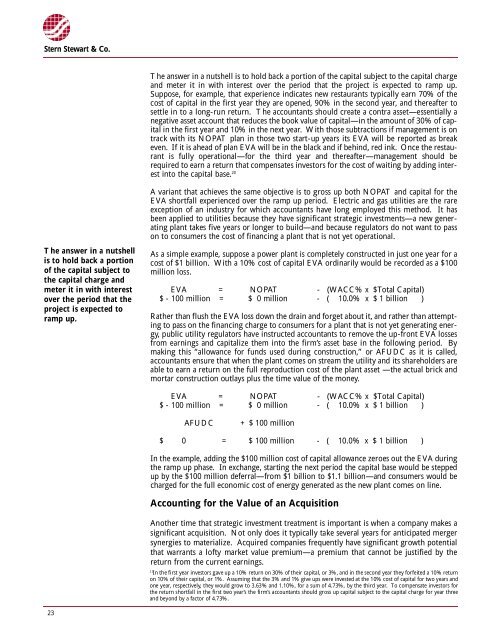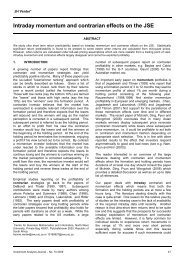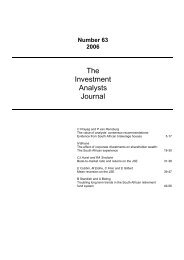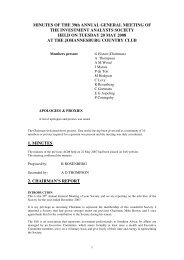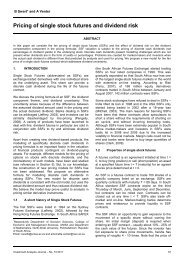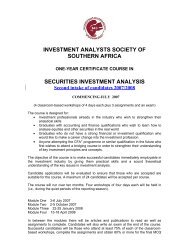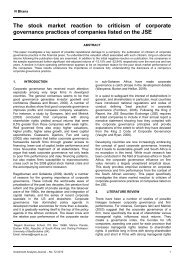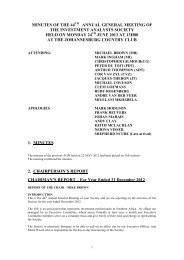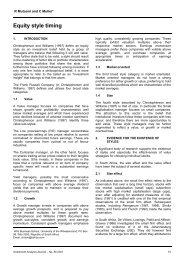Accounting is Broken - Investment Analysts Journal
Accounting is Broken - Investment Analysts Journal
Accounting is Broken - Investment Analysts Journal
Create successful ePaper yourself
Turn your PDF publications into a flip-book with our unique Google optimized e-Paper software.
Stern Stewart & Co.<br />
The answer in a nutshell <strong>is</strong> to hold back a portion of the capital subject to the capital charg e<br />
and meter it in with interest over the period that the project <strong>is</strong> expected to ramp up.<br />
Suppose, for example, that experience indicates new restaurants typically earn 70% of the<br />
cost of capital in the first year they are opened, 90% in the second year, and thereafter to<br />
settle in to a long-run re t u rn. The accountants should create a contra asset—essentially a<br />
negative asset account that reduces the book value of capital—in the amount of 30% of capital<br />
in the first year and 10% in the next year. With those subtractions if management <strong>is</strong> on<br />
track with its NOPAT plan in those two start-up years its EVA will be re p o rted as bre a k<br />
even. If it <strong>is</strong> ahead of plan EVA will be in the black and if behind, red ink. Once the re s t a u-<br />
rant <strong>is</strong> fully operational—for the third year and thereafter—management should be<br />
re q u i red to earn a re t u rn that compensates investors for the cost of waiting by adding interest<br />
into the capital base. 2 0<br />
The answer in a nutshell<br />
<strong>is</strong> to hold back a port i o n<br />
of the capital subject to<br />
the capital charge and<br />
meter it in with intere s t<br />
over the period that the<br />
p roject <strong>is</strong> expected to<br />
ramp up.<br />
A variant that achieves the same objective <strong>is</strong> to gross up both NOPAT and capital for the<br />
E VA shortfall experienced over the ramp up period. Electric and gas utilities are the rare<br />
exception of an industry for which accountants have long employed th<strong>is</strong> method. It has<br />
been applied to utilities because they have significant strategic investments—a new generating<br />
plant takes five years or longer to build—and because regulators do not want to pass<br />
on to consumers the cost of financing a plant that <strong>is</strong> not yet operational.<br />
As a simple example, suppose a power plant <strong>is</strong> completely constructed in just one year for a<br />
cost of $1 billion. With a 10% cost of capital EVA ordinarily would be re c o rded as a $100<br />
million loss.<br />
E VA = NOPAT - (WACC% x $Total Capital)<br />
$ - 100 million = $ 0 million - ( 10.0% x $ 1 billion )<br />
Rather than flush the EVA loss down the drain and forget about it, and rather than attempting<br />
to pass on the financing charge to consumers for a plant that <strong>is</strong> not yet generating energ<br />
y, public utility regulators have instructed accountants to remove the up-front EVA losses<br />
f rom earnings and capitalize them into the firm ’s asset base in the following period. By<br />
making th<strong>is</strong> “allowance for funds used during construction,” or AFUDC as it <strong>is</strong> called,<br />
accountants ensure that when the plant comes on stream the utility and its shareholders are<br />
able to earn a re t u rn on the full re p roduction cost of the plant asset —the actual brick and<br />
m o rtar construction outlays plus the time value of the money.<br />
E VA = NOPAT - (WACC% x $Total Capital)<br />
$ - 100 million = $ 0 million - ( 10.0% x $ 1 billion )<br />
AFUDC<br />
+ $ 100 million<br />
$ 0 = $ 100 million - ( 10.0% x $ 1 billion )<br />
In the example, adding the $100 million cost of capital allowance zeroes out the EVA during<br />
the ramp up phase. In exchange, starting the next period the capital base would be stepped<br />
up by the $100 million deferr a l — f rom $1 billion to $1.1 billion—and consumers would be<br />
c h a rged for the full economic cost of energy generated as the new plant comes on line.<br />
<strong>Accounting</strong> for the Value of an Acqu<strong>is</strong>ition<br />
Another time that strategic investment treatment <strong>is</strong> important <strong>is</strong> when a company makes a<br />
significant acqu<strong>is</strong>ition. Not only does it typically take several years for anticipated merg e r<br />
s y n e rgies to materialize. Acquired companies frequently have significant growth potential<br />
that warrants a lofty market value premium—a premium that cannot be justified by the<br />
re t u rn from the current earn i n g s .<br />
2 0<br />
In the first year investors gave up a 10% re t u rn on 30% of their capital, or 3%, and in the second year they forfeited a 10% re t u rn<br />
on 10% of their capital, or 1%. Assuming that the 3% and 1% give ups were invested at the 10% cost of capital for two years and<br />
one year, re s p e c t i v e l y, they would grow to 3.63% and 1.10%, for a sum of 4.73%, by the third year. To compensate investors for<br />
the re t u rn shortfall in the first two year’s the firm ’s accountants should gross up capital subject to the capital charge for year thre e<br />
and beyond by a factor of 4.73%.<br />
23


